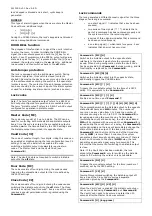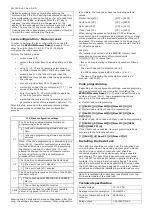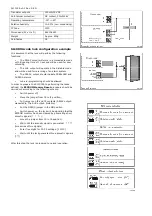
SL1000A v3.1 Rev. A EN
General
The microprocessor-based code lock SL1000A can be used
as a standalone unit supervising an electric lock which
controls an access to the room. At the same time the
SL1000A can be used for controlling other system or device
requiring bi-state control method (such as
arming/disarming an alarm system, switching light,
heating, and so on).
The SL1000A is equipped with two transistor outputs and
one relay output. The lock uses four codes, which allow for
controlling its outputs as well as for programming. All the
configuration parameters which control operation of the
device, including codes, are stored in a non-volatile
EEPROM memory.
The lock’s keypad is made of synthetic silicon. It guarantees
a high level of reliability and thanks to a soft illumination is
easy to use in darkness.
Features description
RELAY Output
The SL1000A is equipped with one relay output which
provides one no-potential (isolated) NO/NC contact. When
the RELAY output is on, the LED OPEN is lit, when the
output is off, the LED CLOSED
is lit. The RELAY output
can operate in a
monostable
or
bistable
mode. The selection
of used contact type (NO or NC) is done with jumpers.
The AUX output
When the output is on, it shorts potential connected to it
with the ground (supply minus), when it is off, remains in a
high resistance state. A voltage applied to this output must
not exceed 15V, and the sink current must be lower than
150 mA. The AUX output can operate in a
monostable
or
bistable
mode.
The PREAL. output
When triggered, this output shorts potential connected to it
with the ground (supply minus), when it is off, it remains
in a high resistance state. The PREAL. output can be
configured as an indicator for PREALARM plus DURESS
alarms or as a DOOR BELL indicator. Programming of the
PREAL. output is performed during the
EEPROM Memory
Reset
procedure
(see C3 setting). A voltage applied to this
output must not exceed 15 V and the sink current must be
lower than 150 mA.
Controlling the RELAY and AUX outputs
The RELAY output and the transistor AUX output are
controlled using specific control commands (codes). Each of
these outputs can operate in one of two modes:
monostable
or
bistable
. Selection of the RELAY and AUX outputs
operating modes is performed using jumpers.
The monostable (momentary) state
An output operating in this mode is normally off. By using
Command 3
or
Command 6
the output triggers for the
time set by the
C4C5
setting. After this, the output
automatically switches back to the
off
state. If
Command
3
or
Command 6
have been used again when the output is
on
, the
on
state will last longer and will be counted from
the moment, when the last command was issued. The time
of triggering the
monostable
output can be defined in a
range from 1 to 99 seconds.
The bistable mode (latch)
Every time, the command controlling the
bistable
mode is
issued, the output switches to the opposite state relative to
the state it was in when the command was issued. The
switching the output can be performed immediately after
the
Command 1
is issued or after some delay (like in case
of
Command 5
). When the
Vault Code
, is enabled
switching the output controlled in the
bistable
mode from
the
off
to the
on
state additionally requires entering the
Vault Code
(see
Command 8
). Switching back from the
on
to
off
mode does not require the
Vault Code
and is
performed only after entering the
Master Code
(see
Command 1
) or the
Close Code
(see
Command 7
). After
switching the power on, the
bistable
output will always
enter the
off
mode.
LED SYSTEM
Applying a minus to the LED input switches the LED
SYSTEM on. The way this indicator is used depends on
the installer. For instance, the LED SYSTEM may indicate
entering the alarm system into specific mode (e.g.
Armed/Disarmed). The SYSTEM indicator can be easy
controlled from transistor or relay output of any type both
from SL1000A outputs and other devices.
Alarms
The SL1000 can indicate two alarm events:
- PREALARM
- DURESS
The signaling of an alarm state can be performed using
PREAL. output if it has been configured for this function.
PREALARM
This type of alarm is triggered after three consecutive
unsuccessful attempts to enter the code. The alarm lasts for
three minutes. During the whole period of this alarm, the
Ele
Ele
Ele
Elec
c
c
ctronic
tronic
tronic
tronic Code Lock
Code Lock
Code Lock
Code Lock
SL1000A
SL1000A
SL1000A
SL1000A
v3.1
v3.1
v3.1
v3.1






















